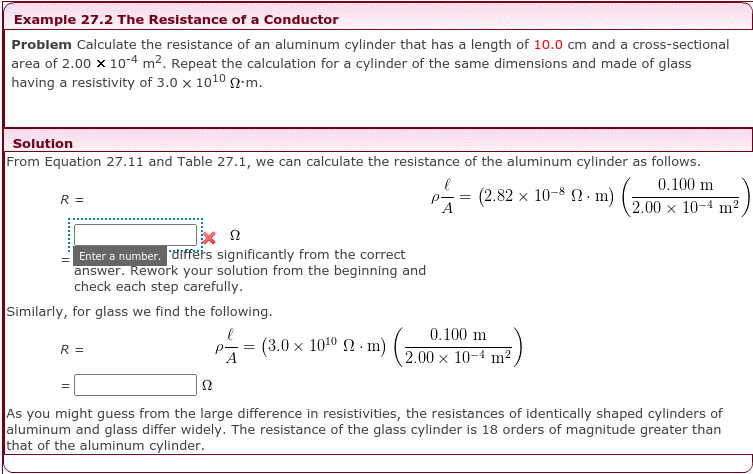Problem Calculate the resistance of an aluminum cylinder that has a length of 10.0 cm and a cross-sectional area of 2.00 x 10-4 m². Repeat the calculation for a cylinder of the same dimensions and made of glass having a resistivity of 3.0 x 1010 N•m.
Problem Calculate the resistance of an aluminum cylinder that has a length of 10.0 cm and a cross-sectional area of 2.00 x 10-4 m². Repeat the calculation for a cylinder of the same dimensions and made of glass having a resistivity of 3.0 x 1010 N•m.
Physics for Scientists and Engineers, Technology Update (No access codes included)
9th Edition
ISBN:9781305116399
Author:Raymond A. Serway, John W. Jewett
Publisher:Raymond A. Serway, John W. Jewett
Chapter27: Current And Resistance
Section: Chapter Questions
Problem 27.4OQ
Related questions
Question

Transcribed Image Text:Example 27.2 The Resistance of a Conductor
Problem Calculate the resistance of an aluminum cylinder that has a length of 10.0 cm and a cross-sectional
area of 2.00 x 10-4 m2. Repeat the calculation for a cylinder of the same dimensions and made of glass
having a resistivity of 3.0 x 10102.m.
Solution
From Equation 27.11 and Table 27.1, we can calculate the resistance of the aluminum cylinder as follows.
0.100 m
-=
(2.82 x 10-8 N. m)
R =
2.00 x 10-4 m?
Enter a number. differs significantly from the correct
answer. Rework your solution from the beginning and
check each step carefully.
Similarly, for glass we find the following.
0.100 m
(3.0 × 1010 2 · m) G
R =
p- =
2.00 x 10-4 m2
As you might guess from the large difference in resistivities, the resistances of identically shaped cylinders of
aluminum and glass differ widely. The resistance of the glass cylinder is 18 orders of magnitude greater than
that of the aluminum cylinder.

Transcribed Image Text:Hints: Getting Started | I'm Stuck
Exercise 27.2
What if the same amount of aluminum is used to make a cylinder with 4.0 times
the original length. What will be the resistance of the resulting cylinder (in units of
un)?
Expert Solution
This question has been solved!
Explore an expertly crafted, step-by-step solution for a thorough understanding of key concepts.
This is a popular solution!
Trending now
This is a popular solution!
Step by step
Solved in 3 steps with 3 images

Recommended textbooks for you

Physics for Scientists and Engineers, Technology …
Physics
ISBN:
9781305116399
Author:
Raymond A. Serway, John W. Jewett
Publisher:
Cengage Learning

College Physics
Physics
ISBN:
9781938168000
Author:
Paul Peter Urone, Roger Hinrichs
Publisher:
OpenStax College

Physics for Scientists and Engineers
Physics
ISBN:
9781337553278
Author:
Raymond A. Serway, John W. Jewett
Publisher:
Cengage Learning

Physics for Scientists and Engineers, Technology …
Physics
ISBN:
9781305116399
Author:
Raymond A. Serway, John W. Jewett
Publisher:
Cengage Learning

College Physics
Physics
ISBN:
9781938168000
Author:
Paul Peter Urone, Roger Hinrichs
Publisher:
OpenStax College

Physics for Scientists and Engineers
Physics
ISBN:
9781337553278
Author:
Raymond A. Serway, John W. Jewett
Publisher:
Cengage Learning

Physics for Scientists and Engineers with Modern …
Physics
ISBN:
9781337553292
Author:
Raymond A. Serway, John W. Jewett
Publisher:
Cengage Learning